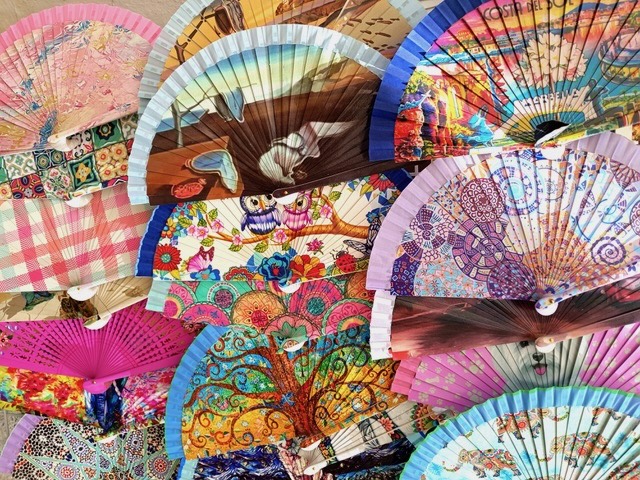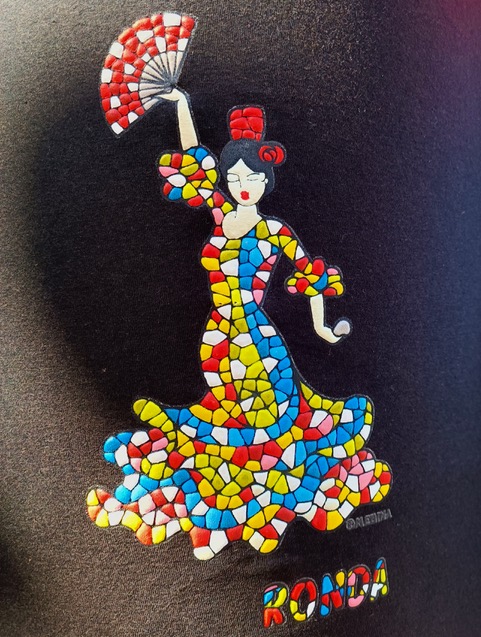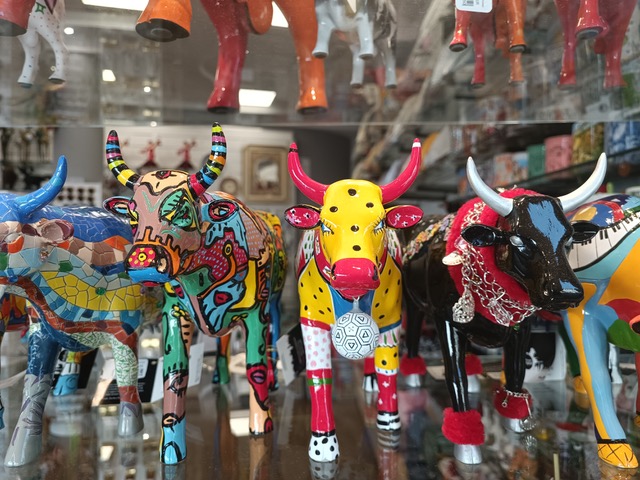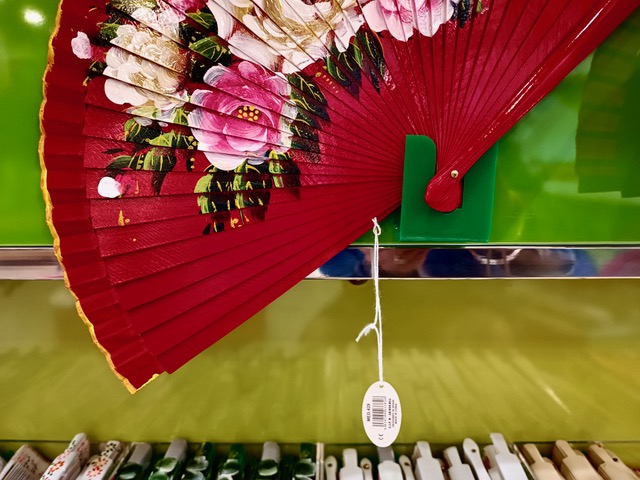
A collection of fans, not made in Spain. Photo © Karethe Linaae
You see them everywhere. Most Spanish shopping streets are filled with tacky souvenir stores. They have walls covered with fans, miles of Spanish-inspired ceramics, figurines of bullfighters and Flamenco dancers, trays with Alhambra patterns, coffee cups and eyeglass cases with reproductions of Picasso’s art, aprons and dish towels with Velasquez’s Las Meninas, castanets in wood and plastic with or without ‘painted’ flower decorations, and even so-called Flamenco dresses. And what does this merchandise have in common? Almost 99 % are made in PRC, meaning that virtually all the ‘Spanish’ souvenirs that tourists bring home from their trip are made in factories in the People’s Republic of China (who started using the alias PRC after Made in China became the universal badge of poor quality).

T-shirt with Flamenco dancer. Photo © Karethe Linaae
When we first visited our present hometown, Ronda, twelve years ago, there were fewer souvenir stores than now. The ones that did exist, had at least a couple of crates with hand-painted antique tiles, a few shelves with an unrefined type of local pottery made in La Serranía, and salad utensils of olive wood that likely were Spanish-made. But almost all of that is gone now. The last gift store that sold genuine Spanish fans disappeared during the Pandemic. Now, virtually all the fans sold in our town are produced in Asia, although the costliest ones claim to be Designed in Spain.
This morning, I stopped by a dozen souvenir stores in town to investigate if anything in their stock was original and Spanish-made. Unfortunately, they are now almost exclusively franchises and chain stores. All have the same mass-produced stock that one will find in their stores in Granada, Sevilla or Barcelona. Only the town name printed on the cup with a bullfighter is altered. Every piece I checked, was made in China, except for some slightly more exclusive-looking ceramics without a label that certainly didn’t appear to be hand-painted.

Bulls abound. Photo © Karethe Linaae
The one item I found that claimed not only to be Designed but Made in Spain, was the classical postcard with a dancing señorita in a real fabric skirt that can be lifted. These are allegedly still made in the Canary Islands, and although they aren’t as nicely embroidered as when I was a child, at least they are Spanish!

The classic Spanish tourist card. Photo © Karethe Linaae
According to El Mercado Global, Spain’s ten most frequently sold souvenirs are postcards, keychains, fridge magnets, fans, T-shirts, castanets, ‘fine China’ thimbles, decorative small plates, Flamenco dresses, and fashion jewellery. And most of these will be cheap and cheery, and almost guaranteed Hecho en PRC.

A genuine Málaga trinket – fridge magnet with live cactus. Photo © Karethe Linaae
If one wishes to invest in a real abanico (fan) made from pear wood with hand-painted silk, it will take one back at least €100. Flamenco dresses, which should be bought in speciality shops, will cost several hundred euros even for a child costume. But these are far from the synthetic junk they sell in the tourist shops. Regretfully, it doesn’t pay for the Spanish to make things by hand any longer – as who will buy a pair of hand-cut castanets in rosewood for €200 if they can buy one in plastic for €4,99? Understandably, not all visitors can or wish to allow themselves the real thing, but it is tragic that most tourists come home from Spain with ‘Spanish’ souvenirs that are far from Spanish.

Made in China. Photo © Karethe Linaae
So, where does one find Spanish souvenirs? One has a greater chance if one goes to an old-fashioned gift store or perhaps a specialty vendor, like a Mercería (Haberdashery) that sells ribbons and sewing supplies or a Zapatería selling riding saddles and other leather goods. Museum stores will often have souvenirs of better quality, but also here one risks buying something that is produced in Asia.
If one wishes to bring home a genuine reminder of the trip, perhaps one’s best bet is to buy something consumable, like local jamón ibérico, a local wild crafted honey, a good quality wine with a DO stamp (Denominacíon de Origen) or a premium extra virgin olive oil from the district one is visiting. At least then one can enjoy the souvenir at home, knowing it is indeed Hecho en España.

Locally produced wine. Photo © Karethe Linaae